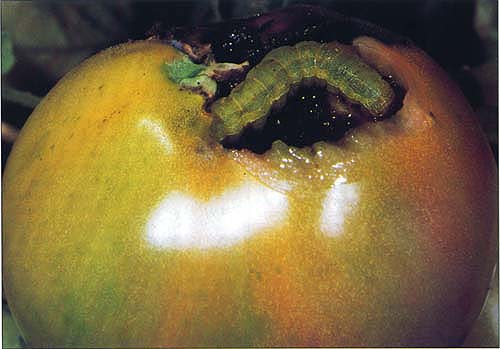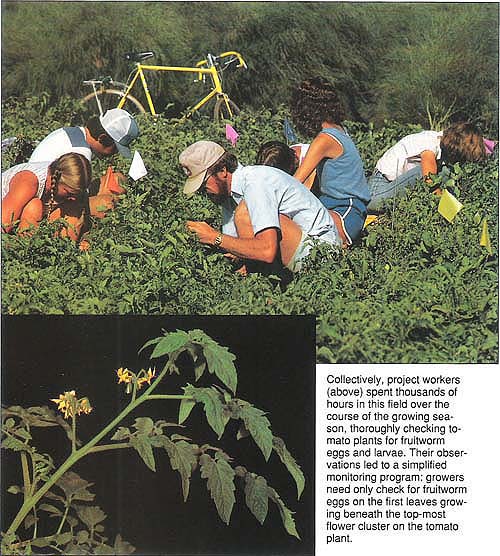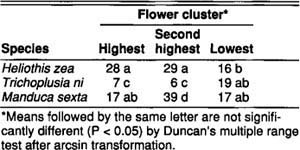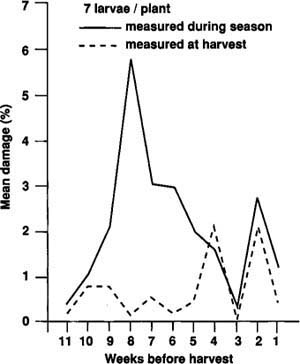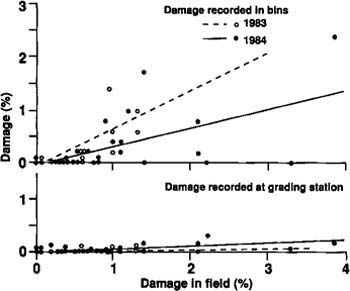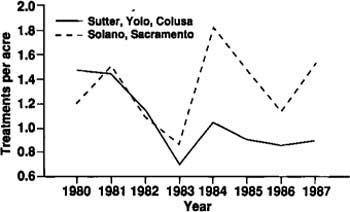All Issues
IPM: Monitoring tomato fruitworm eggs in processing tomatoes
Publication Information
California Agriculture 44(5):12-15.
Published September 01, 1990
PDF | Citation | Permissions
Abstract
Research on egg distribution and treatment levels for the tomato fruitworm led to a set of monitoring guidelines, which were demonstrated in parts of the Sacramento Valley. Evaluation of this program documents grower adoption and an impact on insecticide use.
Full text
Tomato fruitworm (Heliothis zea) larvae attack the fruit of tomatoes and several other California crops, and can render them unmarketable.
The tomato fruitworm, Heliothis zea (Boddie), is among a group of Lepidoptera insects associated with processing tomato production in California. Heliothis zea is the most destructive insect pest in the Sacramento Valley. Historically, it has been the target of most of the insecticides applied to the crop. Growers who took no action to control the pest when it was present in large numbers risked exceeding state standards for damage, or more strict standards imposed by processors. Before this study, some Pest Control Advisers (PCAs) attempted to quantify their field monitoring by using damage estimates from randomly collected fruit. Less commonly, they shook plants over sheets to catch the larvae. Pesticide treatment was considered necessary when the damaged fruit in random fruit counts exceeded 0.25%.
A series of studies was begun in 1981 to develop an easy-to-use monitoring program with research-based damage thresholds. The 8-year process, which involved multiple actors, illustrates a valuable model for development, adoption, education, and evaluation to ensure the use of important agricultural innovations.
Initial research
In 1981, 36 small research plots were established in each of three growers' fields to compare four potential sampling methods. Two plants per plot were removed each week, and the number and location of all fruit, damaged fruit, fruitworm eggs, and larvae were recorded. This study revealed large differences in the average times required to perform each method and in their relative efficiencies. For example, picking 500 fruit from consecutive plants in a row and recording the number of fruit damaged took a worker 80 minutes. Shaking 20 plants onto sheets placed under each plant and counting the dislodged larvae took 80 minutes. Selecting 100 fruit at random and recording the number of damaged fruit took 15 minutes. Picking 30 leaves and counting tomato fruitworm eggs took 8 minutes.
One limitation of the fruit sampling methods is that damage occurs before a treatment decision can be made. Through egg sampling, you can predict damage before the larvae feed upon the fruit. Egg distribution data obtained in 1981 revealed that tomato fruitworm eggs, as well as those of beet armyworm (Spodoptera exigua), cabbage looper (Trichoplusia ni) and hornworms (Manduca spp.), were most frequently laid on leaves that are near flower clusters.
Further egg sampling was conducted in five commercial fields in 1983. Once a week in each field, the leaf below each flower cluster on 12 to 18 plants was selected and the spatial locations of leaves with Lepidoptera eggs were recorded. Eggs of each species were summed over the season by vertical leaf location on the plant, and the percentage of total eggs was determined for each leaf location. Means were separated by Duncan's multiple range test following arcsin transformation.
Results indicated that tomato fruitworm eggs were most frequently found on the leaf below the highest or second highest flower cluster on the plant (table 1). A monitoring plan based upon this knowledge requires fewer samples, since it increases the likelihood of finding eggs. Cabbage looper eggs are similar in color and size to those of tomato fruitworm, but have a somewhat different spatial distribution, with proportionally fewer eggs located on leaves below the higher flower clusters.
Damage potential was estimated by artificially infesting tomato plants every week, beginning after first bloom. In 1982 and 1983, infestation treatments consisted of three levels of first-instar larvae (one, three, and seven per plant) or third-instar larvae (one, three, and five per plant), respectively. A fourth, uninfested treatment served as a control for damage caused by native tomato fruitworms.
Each treatment was replicated six times in 1982 and eight times in 1983. Plots were 0.66 and 2.00 meters long and contained 12 and 20 plants in 1982 and 1983, respectively. All plots were separated by 0.66- to 1.00-meter buffer zones. Plots representing each infestation level were established in a completely randomized block design. Plots infested on different weeks were randomized across field rows.
At weekly intervals for 4 weeks after infestation in 1982 and 2 weeks after infestation in 1983, half of the replicates of each infestation level were thoroughly-examined, and the numbers of larvae and damaged fruit were recorded by age class to provide an indication of the amount of damage observed during the season. The rest of the replicates were left undisturbed. At harvest, the remaining plants were cut off at the base and fruits were shaken onto a drop cloth.
Collectively, project workers (above) spent thousands of hours in this field over the course of the growing season, thoroughly checking tomato plants for fruitworm eggs and larvae. Their observations led to a simplified monitoring program: growers need only check for fruitworm eggs on the first leaves growing beneath the top-most flower cluster on the tomato plant.
Damage recorded at harvest from the undisturbed plots tended to increase as the infestation date approached the harvest date (fig. 1). Before the initiation of pink fruit, the observed damage levels were far in excess of what was recorded in the harvest samples. This, combined with the positive seasonal increase in damage 5 weeks before harvest, indicates that fruit damaged earlier in the season would probably be shed by the plant and so would not be present at harvest, when fruit is inspected. Ultimately, treatment thresholds were selected so that most fields would be graded no higher than “trace” damage (less than 0.5%) by state graders.
Implementation
By 1984, the program was ready for implementation on a pilot basis. Our 1984 guidelines for tomato fruitworm egg monitoring consisted of randomly sampling the leaf below the highest flower cluster on 30 plants per field or field unit (about 40 acres). Sampling was to be conducted at least once per week, beginning when fruit were 1 or more inches in diameter. If the number of eggs exceeded three per 30 leaves, an additional 30 leaves were sampled. Treatment was indicated when four or more eggs were found in the second 30-leaf sample.
Although research on egg sampling and limited validation of the monitoring program were conducted on growers' fields from 1981 through 1983, and results presented at meetings for growers, the first intensive demonstration effort was begun in 1984. The demonstration effort targeted growers and their PCAs in Yolo, Sutter, and Colusa counties. The growers or PCAs were asked to monitor one or two fields. In return, they received training, technical support, and a small stipend, principally for the extra labor involved in recordkeeping.
TABLE 1. Percentage of total eggs in each of five processing tomato fields found on the leaf below the highest, second highest, or lowest flower clusters
Fig. 1. Mean percentage damage, measured during the 1982 season and at harvest on previously unsampled plots, resulting from weekly infestations of seven first-instar tomato fruitworm larvae per plant.
Fig. 2. Comparison of percentage red fruit damaged at harvest, recorded in bulk bins following mechanical harvest and from state graders in 1983 and 1984.
Fig. 3. Number of treatments per processing tomato acre during the period 1980 through 1987 in Sutter, Yolo, and Colusa counties, and in Solano and Sacramento counties. Data are for six pesticides frequently used for control of tomato fruitworm.
Forty-seven fields were monitored as part of the demonstration project, and pesticides were applied as indicated if the number of eggs sampled exceeded the action threshold. Of 1,714 loads delivered to canners from these fields, 1,289 had no damage, 374 were graded as trace damage, and 51 were graded at 0.5% damage. No loads exceeded 0.5% damage. Comparative pesticide use on 35 fields not using the tomato fruitworm egg monitoring program was 12% higher on mid-season fields, and 40% higher on late-season fields. Furthermore, damage was somewhat higher in these fields.
An extensive economic evaluation by UC Davis Agricultural Economists John Antle and Seong Park was conducted along with the 1984 demonstration (see California Agriculture, March-April, 1986). Results of that study, which compared program fields to nonprogram fields, indicated that use of the monitoring program significantly reduced the risk of damage and had a net positive benefit of $7.10 per acre or more depending on the grower's degree of risk aversion.
As part of the 1983 validation efforts and the 1984 demonstration program, researchers assessed tomato fruitworm damage at harvest in many of the monitored fields (8 fields in 1983 and 23 fields in 1984). Three estimates of damage were obtained: (1) 500 fruit taken from 15 consecutive plants in a row being harvested were evaluated for tomato fruitworm damage; (2) once the mechanical harvester had finished picking the row, 500 fruit were randomly selected from the bulk bin and evaluated for damage; and (3) state grade sheets were obtained for the loads.
Figure 2 shows the relationship between fruit damage recorded by hand harvest in the field, from the bins following mechanical harvest, and on the state inspection grade sheets. Field estimates of damage tend to overestimate actual damage in bulk bins and the evaluation of graders. Most damaged fruit probably do not survive the harvesting and transport processes intact. Additionally, some are removed by hand sorters on the harvester. Because our egg-treatment guidelines are based upon estimates of damage in the field, our guidelines are undoubtedly conservative.
Evaluation
Despite its positive attributes, researchers found that the monitoring program was not always adopted. They designed a study to investigate the process and rate of adoption, and possible constraints to adoption.
The study was conducted over 3 months in 1986 in Yolo and Sutter counties and in parts of Colusa and extreme northern Solano counties. Researchers interviewed representatives of 84 of the 100 farming enterprises that grew processing tomatoes in the area. The interview design was pre-tested with four growers who had participated in the original tomato IPM program, but who lived outside the interview area. Growers interviewed were either the owners, working relatives of the owners, or managers of the enterprises.
The question, “Have you heard of Integrated Pest Management or IPM?” was answered “yes” by 70%, “no” by 23%, and “not sure” by 7% of the growers. Eighty-one percent indicated they had heard of the “UC Worm Sampling Method.”
Of the 82 growers who could be classified as adopters or nonadopters (2 could not be categorized), 26% had fully adopted the method and 31% had adopted the program in theory but had modified it for their use. Of the remaining growers who had not adopted the monitoring program, 31% were considering adoption, 6% had rejected the program, and 6% had no intention of using IPM methods.
The most frequent reasons given for adopting the monitoring program were the possibility of financial gain (63%) and the possibility of reducing damage (52%). Of all background and demographic questions related to type of enterprise, farm size, educational level, and computer ownership, significant differences based on t tests were found between adopters and nonadopters only in terms of land ownership (P <0.03), with owners more likely to adopt than nonowners, and a grower's IPM use for other crops (P <0.001).
Epilogue
Pesticide use reports for 1980 through 1987 (the most recent date individual county data were available at the time of writing) in Colusa, Sacramento, Solano, Sutter, and Yolo counties were obtained for the seven pesticides commonly applied to control tomato fruitworm during this period. Six of the materialsNdashmethomyl, methamidophos, azinphosmethyl, carbaryl, fenvalerate, and methyl parathionNdashare restricted, or are typically applied by commercial applicators. Therefore, their reporting should be accurate. However, the other material, Bacillus thuringiensis, is neither restricted nor typically applied by commercial applicators.
Some of the materials are often applied for other pests as well, a factor that would tend to result in an overestimate of actual use for tomato fruitworm. For example, carbaryl is often applied for seedling pests like flea beetles, and methamidophos and methyl parathion are often applied for stinkbugs. For these materials, we assume that treatment for other pests was constant during this period. Figure 3 indicates that the use of these materials, as indicated by the number of treatments per acre, declined significantly during the period in Sutter, Yolo, and Colusa counties, where the extensive implementation program was conducted, whereas little change was observed in neighboring Solano and Sacramento counties, where implementation was not actively pursued.
An additional benefit of egg sampling has been the observation that several naturally occurring Trichogramma wasp species, which are egg parasites of the tomato fruitworm, are very important in the Sacramento Valley. Eggs parasitized by these tiny wasps turn black and can easily be identified. Parasitism by Trichogramma spp. reached 80% or more in mid-August and September (see California Agriculture, January-February, 1990). Demonstration efforts are now being conducted to incorporate the occurrence of these parasites into treatment guidelines. This could result in further reductions in pesticide use for tomato fruitworm.
Development and diffusion of the egg-monitoring program represents the combined efforts of both campus- and county-based research and extension staff, and included both agricultural and social scientists. We believe that this approach provides a model for the process of development, adaptation, evaluation, and education, which is essential in bringing any agricultural innovation into use. This is especially true of this IPM strategy, which substituted information for a routine agronomic practice, preventative pesticide treatment.



